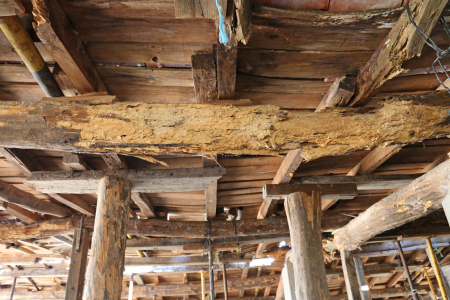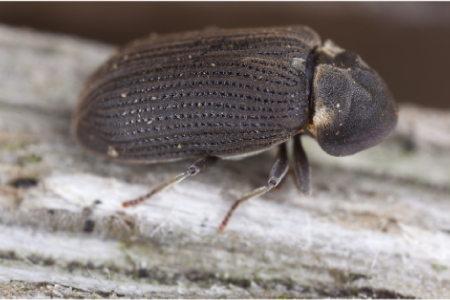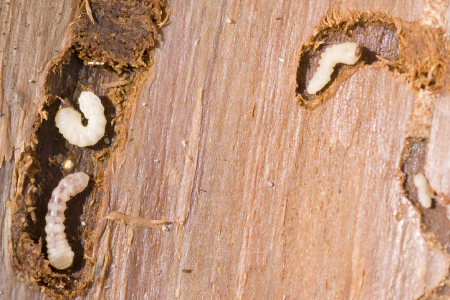Should I Buy a House with Woodworm?
Have you found woodworm in a potential new home? We know it can be unsettling, but don't panic just yet. This common issue can influence property value and even your living conditions. However, it's not always a deal-breaker.
- Whether or not to buy a house with woodworm depends on several factors, including the severity of the infestation, the cost of treatment, and the property's overall condition. Weigh the pros and cons before making a decision.
- Woodworm is a serious issue that can significantly impact property value and living conditions. While it's treatable, the cost and inconvenience of treatment should be considered.
- A professional survey is crucial when purchasing a property, regardless of its condition. It can accurately assess the extent of a woodworm infestation, provide treatment options, and help you determine the property's value.
What is woodworm?
Woodworm is a common term for the larvae of various beetle species that feed on wood. These beetles lay their eggs in timber, and the hatched larvae burrow through the wood, creating tunnels and destroying the structural integrity of the timber.
The lifecycle of a woodworm typically involves four stages: egg, larva, pupa, and adult. The larva is the most destructive stage, feeding on wood for several years. Once mature, the larva pupates and transforms into an adult beetle. Adult woodworms do not cause significant damage, but they emerge from the wood to mate and lay eggs, starting the cycle again.
Woodworm infestations are most likely to strike in areas with warm, dry-ish conditions, poor ventilation, and lots of timber. This often includes:
Roof spaces and attics: Warm, dry conditions create an ideal breeding ground for wood-boring beetles.
Floorboards: Particularly vulnerable in damp or poorly ventilated areas.
Staircases: Timber construction makes them prime targets for woodworm.
Timber framing:Trusses, wall plates, and lintels are at risk, especially when in contact with damp masonry.
Woodworm survey cost
If you're buying with a mortgage, the lender might make it a condition for you to book this survey. However, if you're a cash buyer, or if you already own the property, you can also get a damp and timber survey.
A damp and timber survey is a professional assessment of the extent of the woodworm problem and costs start from £264 EXC VAT.
Should a surveyor pick up woodworm?
Yes, your surveyor will be able to pick up signs of woodworm. They are trained to look for tell-tale signs such as exit holes, wood dust, and weakened timber. While they can't always guarantee detection, especially in the early stages, a thorough survey should highlight significant issues and is a must for any home buyer.
You will need a Level 2 or Level 3 Survey and this will note any signs of woodworm. If woodworm is confirmed, you'll be advised to get a damp and timber survey to assess the damage and recommend any intrusive investigation or immediate remediation and estimated costs.
Can I get a mortgage on a house with woodworm?
Depending on how serious the infestation is, lenders might refuse to grant you a mortgage because they need to be confident they could sell the property to recover their money if you default on your mortgage. If the infestation is severe, the property could become dangerous and worthless.
The lender might ask you to treat the woodworm as a condition before loaning you the amount you need; you should always consult a mortgage adviser to understand the implications of woodworm on your potential new property purchase.
The role of a buyer and a seller in woodworm infestation
Sellers should declare known defects that could affect the property's value. This is a legal requirement when selling any property. While woodworm might not always be apparent, if the seller was aware of the issue, they should have told the buyer.
Buyers, on the other hand, are responsible for property inspections to identify potential problems. A home survey can help identify signs of woodworm infestation, but it's essential to then book a damp and timber survey in addition to a home survey.
Discovering woodworm in your dream home can be disheartening, but you do have options:
- Walk away: If the infestation is severe or the property has other significant issues, it might be best to continue your search.
- Negotiate with the seller: Request a price reduction to account for the cost of treatment. Obtaining multiple quotes for the work can strengthen your negotiating position.
- Insist on treatment: Ask the seller to arrange professional woodworm treatment before the sale is completed. Request proof of treatment upon completion.
- DIY or hire a professional: If you're comfortable with the property and the extent of the infestation, you can opt to treat the woodworm yourself or hire a specialist.
In our recent survey, 16% of homeowners found defects; including 2% who were able to pull out of a bad purchase, 7% who were able to negotiate a better price, and sadly, 7% of homeowners who did not get a survey and discovered defects after the purchase.
12 of the 39 who remembered how much these defects cost to remedy spent over £5,000
Don't burn your money, book a survey.

Is woodworm a serious problem?
Yes, woodworm can be a severe issue if left untreated. While small infestations might not cause immediate structural damage, a prolonged problem can weaken timber and compromise the structural integrity.



Fixing woodworm may cost upwards of £1,000 and replacing damaged timber can be even more costly.
Factors that can influence the severity of a woodworm infestation include:
Types of woodworm
There are many different types of woodworm, each requiring a different technique to remedy.
- Common Furniture Beetle (Anobium Punctatum) - this is the most common in the UK and attacks softwood and the sapwood of European hardwoods.
- House Longhorn Beetle - only attacks the sapwood of softwood timbers, rare in the UK.
- Powderpost Beetle - causes damage to ash, elm, and oak (all have a high starch content).
- Deathwatch Beetle - prefers European hardwoods, especially oak, ash, and chestnut. Larvae tunnel towards the centre of timber so damage may be more extensive than visible from the exterior.
Extent of the infestation
The number of exit holes and affected areas indicate the severity.
Number and Location of Exit Holes | Possible Indication |
| Small number of holes, scattered throughout the property | Limited or past infestation |
| Large number of holes, clustered together | Active and widespread infestation |
| Exit holes appearing near windows or doors | A potential entry point for woodworm |
| Exit holes on structural timbers (floor joists, roof beams, load-bearing walls) | Serious concern, requiring professional attention |
Age and condition of the timber
Older timber is generally more susceptible to woodworm infestation for several reasons:
- Natural weakening: Over time, wood naturally weakens and loses its resistance to pests.
- Less robust materials: Older properties might have been constructed with less robust building materials, making them more vulnerable to woodworm damage.
- Damaged wood: Damaged wood, particularly wood with cracks, moisture issues, or previous woodworm activity, provides easier access and a more favourable environment for woodworm to thrive.
- Untreated wood: Untreated wood is especially vulnerable to woodworm infestation as it lacks resistance to pests.
Can wood with woodworm be saved?
Wood with woodworm can be saved, but the key is early detection and appropriate treatment. A timber specialist surveyor will need to identify the species of woodworm, check if the infestation is still active, and then see which timbers need to be replaced.
Pre-treated timber will then need to be installed to replace the structurally weakened bits of wood and then the existing woodwork will have to be treated too.
Types of treatment and costs
These are approximate figures and actual costs can vary significantly based on location, property size, severity of infestation, and your chosen company.
Injection Treatments
£500 - £1,000 per treatment, often involving multiple treatments.
- Ideal for deeper infestations in structural timbers.
- Involves drilling holes into the wood and injecting a woodworm treatment.
- Targets larvae within the wood.
- Provides long-lasting protection.
Surface treatments
£200 - £500 per treatment, depending on the size of the affected area.
- Suitable for minor infestations on furniture or exposed timbers.
- Involves applying a woodworm killer directly to the affected areas.
- Products often come in spray, gel, or liquid form.
- Requires repeated applications to target different life stages.
While prevention costs might seem higher upfront, they can save you significant expenses in the long run by preventing a costly woodworm infestation.
Andrew started his career in 2000 working within conveyancing solicitor firms and grew hands-on knowledge of a wide variety of conveyancing challenges and solutions. After helping in excess of 50,000 clients in his career, he uses all this experience within his article writing for SAM, mainstream media and his self published book How to Buy a House Without Killing Anyone.
Caragh is an excellent writer and copy editor of books, news articles and editorials. She has written extensively for SAM for a variety of conveyancing, survey, property law and mortgage-related articles.









